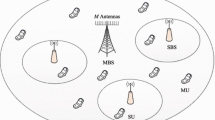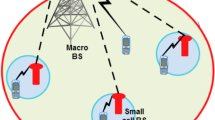Abstract
Dense deployment of small cells escalates the network capacity, making it a candidate technology for the future wireless network. However, backhauling of such a large number of small cells becomes a major challenge in its successful deployment. In this paper, a framework for massive MIMO enabled wireless backhauling in a two-tier heterogeneous network is developed. The framework considers massive MIMO enabled macro base station and in-band full-duplex (IBFD) small cell base station. Massive MIMO system provides high spectral efficiency and high energy efficiency. Besides, due to IBFD capability, the small cells can utilize the same frequency band to communicate over the access link and the backhaul link simultaneously. Tools from the stochastic geometry are utilized to model and derive the analytical expressions of coverage probability and area spectral efficiency (ASE). Furthermore, a trade-off between ASE and coverage probability is observed. All the analytical results are verified by simulation. Simulation results show that massive MIMO and IBFD communication may be useful technologies from the backhauling perspective in the dense small cell network. It is observed that the proposed framework provides 42.30% improvement in the coverage performance over the other existing framework for rate threshold of 1 bps/Hz. Furthermore, optimal performance for the proposed model can be achieved by tuning of bandwidth allocation factor.









Similar content being viewed by others
References
Cisco. (2018). Cisco visual networking index: Forecast and trends. https://www.cisco.com/c/en/us/solutions/collateral/service-provider/visual-networking-index-vni/white-paper-c11-741490.html. Accessed Mar 2018.
Hwang, I., Song, B., & Soliman, S. S. (2013). A holistic view on hyper-dense heterogeneous and small cell networks. IEEE Communications Magazine, 51(6), 20–27. https://doi.org/10.1109/MCOM.2013.6525591.
Kazi, B. U., & Wainer, G. A. (2019). Next generation wireless cellular networks: Ultra-dense multi-tier and multi-cell cooperation perspective. Wireless Networks, 25(4), 2041–2064. https://doi.org/10.1007/s11276-018-1796-y.
Kamel, M., Hamouda, W., & Youssef, A. (2016). Ultra-dense networks: A survey. IEEE Communications Surveys Tutorials, 18(4), 2522–2545. https://doi.org/10.1109/COMST.2016.2571730.
Kela, P., Costa, M., Turkka, J., Leppanen, K., & Jantti, R. (2016). Flexible backhauling with massive mimo for ultra-dense networks. IEEE Access, 4, 9625–9634. https://doi.org/10.1109/ACCESS.2016.2634039.
Tabassum, H., Sakr, A. H., & Hossain, E. (2016). Analysis of massive mimo-enabled downlink wireless backhauling for full-duplex small cells. IEEE Transactions on Communications, 64(6), 2354–2369. https://doi.org/10.1109/TCOMM.2016.2555908.
Yang, H. H., Geraci, G., & Quek, T. Q. S. (2016). Energy-efficient design of mimo heterogeneous networks with wireless backhaul. IEEE Transactions on Wireless Communications, 15(7), 4914–4927. https://doi.org/10.1109/TWC.2016.2549529.
Larsson, E. G., Edfors, O., Tufvesson, F., & Marzetta, T. L. (2014). Massive mimo for next generation wireless systems. IEEE Communications Magazine, 52(2), 186–195. https://doi.org/10.1109/MCOM.2014.6736761.
Rajoria, S., Trivedi, A., & Godfrey, W. W. (2018). A comprehensive survey: Small cell meets massive mimo. Physical Communication, 26, 40–49. https://doi.org/10.1016/j.phycom.2017.11.004.
Duarte, M., Sabharwal, A., Aggarwal, V., Jana, R., Ramakrishnan, K. K., Rice, C. W., et al. (2014). Design and characterization of a full-duplex multiantenna system for wifi networks. IEEE Transactions on Vehicular Technology, 63(3), 1160–1177. https://doi.org/10.1109/TVT.2013.2284712.
Choi, J. I., Jain, M., Srinivasan, K., Levis, P., & Katti, S. (2010). Achieving single channel, full duplex wireless communication. In Proceedings of the sixteenth annual international conference on Mobile computing and networking (MobiCom '10) (pp 1–12). New York, NY: ACM. https://doi.org/10.1145/1859995.1859997.
Chen, L., Yu, F. R., Ji, H., Rong, B., & Leung, V. C. M. (2018). Power allocation in small cell networks with full-duplex self-backhauls and massive mimo. Wireless Networks, 24(4), 1083–1098. https://doi.org/10.1007/s11276-016-1381-1.
Li, B., Zhu, D., & Liang, P. (2015). Small cell in-band wireless backhaul in massive mimo systems: A cooperation of next-generation techniques. IEEE Transactions on Wireless Communications, 14(12), 7057–7069. https://doi.org/10.1109/TWC.2015.2464299.
Shojaeifard, A., Wong, K. K., Di Renzo, M., Zheng, G., Hamdi, K. A., & Tang, J. (2017). Massive mimo-enabled full-duplex cellular networks. IEEE Transactions on Communications, 65(11), 4734–4750. https://doi.org/10.1109/TCOMM.2017.2731768.
Dhillon, H. S., Ganti, R. K., & Andrews, J. G. (2011). A tractable framework for coverage and outage in heterogeneous cellular networks. In: Proceedings of 2011 Information Theory and Applications Workshop (pp. 1–6). https://doi.org/10.1109/ITA.2011.5743604.
Jiang, Y., Zou, Y., Guo, H., Tsiftsis, T. A., Bhatnagar, M. R., de Lamare, R. C., et al. (2019). Joint power and bandwidth allocation for energy-efficient heterogeneous cellular networks. IEEE Transactions on Communications, 67(9), 6168–6178. https://doi.org/10.1109/TCOMM.2019.2921022.
Xie, Y., Li, B., Zuo, X., Yan, Z., & Yang, M. (2018). Performance analysis for 5g beamforming heterogeneous networks. Wireless Networks,. https://doi.org/10.1007/s11276-018-1846-5.
He, A., Wang, L., Chen, Y., Elkashlan, M., & Wong, K. (2015). Massive MIMO in k-tier heterogeneous cellular networks: Coverage and rate. In: 2015 IEEE Global Communications Conference (GLOBECOM) (pp. 1–6). https://doi.org/10.1109/GLOCOM.2015.7417732.
He, A., Wang, L., Elkashlan, M., Chen, Y., & Wong, K. K. (2015). Spectrum and energy efficiency in massive mimo enabled hetnets: A stochastic geometry approach. IEEE Communications Letters, 19(12), 2294–2297. https://doi.org/10.1109/LCOMM.2015.2493060.
Li, C., Zhang, J., Andrews, J. G., & Letaief, K. B. (2016). Success probability and area spectral efficiency in multiuser mimo hetnets. IEEE Transactions on Communications, 64(4), 1544–1556. https://doi.org/10.1109/TCOMM.2016.2531719.
Xie, H., Gao, F., Zhang, S., & Jin, S. (2017). A unified transmission strategy for tdd/fdd massive mimo systems with spatial basis expansion model. IEEE Transactions on Vehicular Technology, 66(4), 3170–3184. https://doi.org/10.1109/TVT.2016.2594706.
Ma, J., Zhang, S., Li, H., Gao, F., & Jin, S. (2019). Sparse bayesian learning for the time-varying massive mimo channels: Acquisition and tracking. IEEE Transactions on Communications, 67(3), 1925–1938. https://doi.org/10.1109/TCOMM.2018.2855197.
Ma, J., Zhang, S., Li, H., Zhao, N., & Leung, V. C. M. (2018). Interference-alignment and soft-space-reuse based cooperative transmission for multi-cell massive mimo networks. IEEE Transactions on Wireless Communications, 17(3), 1907–1922. https://doi.org/10.1109/TWC.2017.2786722.
Akbar, S., Deng, Y., Nallanathan, A., Elkashlan, M., & Karagiannidis, G. K. (2017). Massive multiuser mimo in heterogeneous cellular networks with full duplex small cells. IEEE Transactions on Communications, 65(11), 4704–4719. https://doi.org/10.1109/TCOMM.2017.2728536.
Sharma, A., Ganti, R. K., & Milleth, J. K. (2017). Joint backhaul-access analysis of full duplex self-backhauling heterogeneous networks. IEEE Transactions on Wireless Communications, 16(3), 1727–1740. https://doi.org/10.1109/TWC.2017.2653108.
Zhang, Z., Wang, X., Long, K., Vasilakos, A. V., & Hanzo, L. (2015). Large-scale mimo-based wireless backhaul in 5g networks. IEEE Wireless Communications, 22(5), 58–66. https://doi.org/10.1109/MWC.2015.7306538.
Chen, D. C., Quek, T. Q. S., & Kountouris, M. (2015). Backhauling in heterogeneous cellular networks: Modeling and tradeoffs. IEEE Transactions on Wireless Communications, 14(6), 3194–3206. https://doi.org/10.1109/TWC.2015.2403321.
Chen, L., Yu, F. R., Ji, H., Rong, B., Li, X., & Leung, V. C. M. (2016). Green full-duplex self-backhaul and energy harvesting small cell networks with massive mimo. IEEE Journal on Selected Areas in Communications, 34(12), 3709–3724. https://doi.org/10.1109/JSAC.2016.2611846.
Liu, Y., Lu, L., Li, G. Y., Cui, Q., & Han, W. (2016). Joint user association and spectrum allocation for small cell networks with wireless backhauls. IEEE Wireless Communications Letters, 5(5), 496–499. https://doi.org/10.1109/LWC.2016.2593465.
Wang, N., Hossain, E., & Bhargava, V. K. (2016). Joint downlink cell association and bandwidth allocation for wireless backhauling in two-tier hetnets with large-scale antenna arrays. IEEE Transactions on Wireless Communications, 15(5), 3251–3268. https://doi.org/10.1109/TWC.2016.2519401.
Andrews, J. G., Gupta, A. K., & Dhillon, H. S. (2016). A primer on cellular network analysis using stochastic geometry. CoRR. arXiv:1604.03183.
Benmimoune, M., Driouch, E., Ajib, W., & Massicotte, D. (2017). Novel transmit antenna selection strategy for massive mimo downlink channel. Wireless Networks, 23(8), 2473–2484. https://doi.org/10.1007/s11276-016-1297-9.
Hosseini, K., Yu, W., & Adve, R. S. (2014). Large-scale mimo versus network mimo for multicell interference mitigation. IEEE Journal of Selected Topics in Signal Processing, 8(5), 930–941. https://doi.org/10.1109/JSTSP.2014.2327594.
Jo, H. S., Sang, Y. J., Xia, P., & Andrews, J. G. (2012). Heterogeneous cellular networks with flexible cell association: A comprehensive downlink sinr analysis. IEEE Transactions on Wireless Communications, 11(10), 3484–3495. https://doi.org/10.1109/TWC.2012.081612.111361.
Thilina, K. M., Tabassum, H., Hossain, E., & Kim, D. I. (2015). Medium access control design for full duplex wireless systems: challenges and approaches. IEEE Communications Magazine, 53(5), 112–120. https://doi.org/10.1109/MCOM.2015.7105649.
Masmoudi, A., & Le-Ngoc, T. (2017). Full-duplex wireless communications systems. Berlin: Springer. https://doi.org/10.1007/978-3-319-57690-9.
Alouini, M., & Goldsmith, A. J. (1999). Area spectral efficiency of cellular mobile radio systems. IEEE Transactions on Vehicular Technology, 48(4), 1047–1066. https://doi.org/10.1109/25.775355.
Xin, Y., Wang, D., Li, J., Zhu, H., Wang, J., & You, X. (2016). Area spectral efficiency and area energy efficiency of massive mimo cellular systems. IEEE Transactions on Vehicular Technology, 65(5), 3243–3254. https://doi.org/10.1109/TVT.2015.2436896.
Jose, J., Ashikhmin, A., Marzetta, T. L., & Vishwanath, S. (2011). Pilot contamination and precoding in multi-cell tdd systems. IEEE Transactions on Wireless Communications, 10(8), 2640–2651. https://doi.org/10.1109/TWC.2011.060711.101155.
Wang, C., Au, E. K. S., Murch, R. D., & Lau, V. K. N. (2006). Closed-form outage probability and ber of mimo zero-forcing receiver in the presence of imperfect csi. In 2006 IEEE 7th workshop on signal processing advances in wireless communications (pp. 1–5). https://doi.org/10.1109/SPAWC.2006.346359.
Author information
Authors and Affiliations
Corresponding author
Additional information
Publisher's Note
Springer Nature remains neutral with regard to jurisdictional claims in published maps and institutional affiliations.
Appendices
Appendix 1: Proof of Lemma 1
Let q denotes the index of the serving tier. Also, the index of the MBS and SBS tier are represented as m and s, respectively. Accordingly, the probability that user is served by MBS is
where (a) is obtained by substituting (2) and (3) in (40) and (b) can be obtained by averaging \(P(\bullet )\) in (41) over the distribution of \(T_{m}\). Moreover, \(P\left[ {{T_s} > {{\left( {\frac{{L{P_s}}}{{\left( {N - L - 1} \right) {P_m}}}} \right) }^{1/\delta }}{T_m}} \right]\) and \({f_{{T_m}}}\left( t \right)\) can be derived by the application of the null probability of a 2-D Poisson process with density \(\lambda\) in an area A is \(exp(\lambda A)\). Following this
and
Appendix 2: Proof of Theorem 1
Proceeding with (21), downlink rate coverage probability of MBS to user link can be derived as
After substituting the values of \(SINR_{a,m}\) and \({f_{{X_{m,u}}}}({x_{m,u}})\) from (11) and (6), (50) can be modified as
where \({{F_{{I_1}}[\bullet ]}}\) is the CDF of the aggregate interference, and Gil-Pelaez theorem is applied to evaluate the aforementioned CDF.
herein \({L_{{I_{m,{u_m}}}}}(s)\) and \({L_{{I_{s,{u_m}}}}}(s)\) are the Laplace transform of the interferences \({{I_{m,{u_m}}}}\) and \({{I_{s,{u_m}}}}\), respectively and can be derived as follows
where (a) is due to the independence of interfering links, (b) follows the probability generating functional (PGFL) of PPP, and (c) is achieved by solving the integration.
Thereafter, \({L_{{I_{s,{u_m}}}}}(s)\) can be calculated as
by the PGFL of PPP
Now, from (60)
By using the Kumar’s formula
Appendix 3: Proof of Theorem 2
Steps for deriving the coverage probability when a user is connected with SBS are as follows
where
and \(P(\bullet )\) is derived below. Since channel is Rayleigh distributed with unit mean, (71) can be simplified as
where \({L_{{I_{s,{u_s}}}}}\left( s \right)\) and \({L_{{I_{m,{u_s}}}}}\left( s \right)\) are the Laplace transform of the interferences \(I_{s,u_{s}}\) and \(I_{m,u_{s}}\), respectively for \(s = \frac{{{\tau _{a,s}}x_{s,u}^\delta }}{{{P_s}}}\). These can be calculated with the same procedure which is explained in Theorem 1 and are given as follows
Appendix 4: Proof of Theorem 3
Coverage probability of backhaul link (i.e., SBS associated with the MBS) can be derived analogous to the proof of Theorem 1. Moreover, key steps therein are mentioned below.
where \({{F_{{I_2}}(\bullet )}}\) is the CDF of the aggregate interference, and Gil-Pelaez theorem is applied to evaluate the aforementioned CDF.
where \({L_{{I_{m,s}}}}(s)\) and \({L_{{I_{s,s}}}}(s)\) are the Laplace transform of the interferences \(I_{m,s}\) and \(I_{s,s}\), respectively and can be evaluated as
Rights and permissions
About this article
Cite this article
Rajoria, S., Trivedi, A. & Godfrey, W.W. Performance analysis of two tier HetNets with massive MIMO enabled wireless backhauling. Wireless Netw 26, 1459–1472 (2020). https://doi.org/10.1007/s11276-019-02205-1
Published:
Issue Date:
DOI: https://doi.org/10.1007/s11276-019-02205-1




